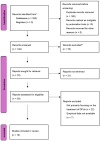A systematic review and meta-analysis of treatment modalities and their impact on the healing progression of diabetic foot ulcers
- PMID: 40400718
- PMCID: PMC12089822
- DOI: 10.62347/WVEM7973
A systematic review and meta-analysis of treatment modalities and their impact on the healing progression of diabetic foot ulcers
Abstract
Background: The diabetic foot ulcer (DFU) is a common and serious complication of diabetes mellitus, which occurs in 15-25% of diabetic patients at some point in their lives. However, most of the Diabetic foot ulcers (DFUs) do not heal with conventional methods of wound care and progress to become chronic, non-healing ulcers with high morbidity, mortality, and economic stakes. Some of the recent techniques in the management of ulcers include Systemic Hyperbaric Oxygen Therapy (s-HBOT), Platelet-Rich Plasma (PRP), Vacuum-Assisted Closure (VAC) Therapy, and Negative Pressure Wound Therapy (NPWT) that aim at improving the ulcer healing rate and minimize the risks of amputation.
Objective: This work intends to conduct a comprehensive meta-analysis of the effectiveness, healing time and effect on amputation of these advanced treatment modalities on management of DFUs.
Methods: The present study followed the Preferred Reporting Items for Systematic Reviews and Meta-Analyses (PRISMA) guidelines for the reporting of systematic reviews and meta-analysis of randomized controlled trials. Information was obtained from 10 researches that considered different types of DFU treatment. The major end-points studied were rates of ulcer healing, time to heal and frequency of lower extremity amputations. The meta-analysis was conducted using R statistical software and the synthesis of results was done using forest and funnel plots.
Results: The pooled analysis showed that NPWT significantly improved ulcer healing rates (OR = 2.07, 95% CI: 1.09-3.05) and reduced time to healing (Mean Diff = -22 days, 95% CI: -41.60 to -2.40). HBOT, particularly s-HBOT, demonstrated a substantial reduction in amputation rates (OR = 0.08, 95% CI: -0.11-0.28). PRP also showed promise, especially in reducing healing time (Mean Diff = -25 days, 95% CI: -34.80 to -15.20), though with more variability across studies.
Conclusion: The results of NPWT were found to be significantly superior for ulcer closure and reduced healing time making it the treatment of choice for DFUs. Compared to controls, both HBOT and s-HBOT were strikingly effective in averting amputations. PRP had the possibility of being used as supplementary treatment especially in treatment with regard to the aspect of promotion of healing. Collectively, these results suggest that it is possible to use such advanced therapies to enhance the treatment of DFU; however, more effort is required to refine the protocols of such therapies and determine the sources of a differential response.
Keywords: Diabetic foot ulcers (DFU); amputation; hyperbaric oxygen therapy (HBOT); meta-analysis; negative pressure wound therapy (NPWT); platelet-rich plasma (PRP); vacuum-assisted closure (VAC) therapy; wound healing.
IJBT Copyright © 2025.
Conflict of interest statement
None.
Figures





Similar articles
-
Effects of different treatment measures on the efficacy of diabetic foot ulcers: a network meta-analysis.Front Endocrinol (Lausanne). 2024 Sep 23;15:1452192. doi: 10.3389/fendo.2024.1452192. eCollection 2024. Front Endocrinol (Lausanne). 2024. PMID: 39377075 Free PMC article.
-
Hyperbaric oxygen therapy for non-healing ulcers in diabetes mellitus: an evidence-based analysis.Ont Health Technol Assess Ser. 2005;5(11):1-28. Epub 2005 Sep 1. Ont Health Technol Assess Ser. 2005. PMID: 23074462 Free PMC article.
-
Poorly designed research does not help clarify the role of hyperbaric oxygen in the treatment of chronic diabetic foot ulcers.Diving Hyperb Med. 2016 Sep;46(3):133-134. Diving Hyperb Med. 2016. PMID: 27723012
-
The role of hyperbaric oxygen therapy in the treatment of diabetic foot ulcers: a systematic review with meta-analysis of randomized controlled trials on limb amputation and ulcer healing.Int Angiol. 2022 Feb;41(1):63-73. doi: 10.23736/S0392-9590.21.04722-2. Epub 2021 Jul 8. Int Angiol. 2022. PMID: 34236155
-
A systematic review and meta-analysis of hyperbaric oxygen therapy for diabetic foot ulcers with arterial insufficiency.J Vasc Surg. 2020 Feb;71(2):682-692.e1. doi: 10.1016/j.jvs.2019.07.082. J Vasc Surg. 2020. PMID: 32040434
References
-
- Caruso P, Longo M, Gicchino M, Scappaticcio L, Caputo M, Maiorino MI, Bellastella G, Esposito K. Long-term diabetic complications as predictors of foot ulcers healing failure: a retrospective study in a tertiary-care center. Diabetes Res Clin Pract. 2020;163:108147. - PubMed
-
- Moore Z, Avsar P, Wilson P, Mairghani M, O’Connor T, Nugent L, Patton D. Diabetic foot ulcers: treatment overview and cost considerations. J Wound Care. 2021;30:786–791. - PubMed
-
- Mairghani M. Diabetic Foot Ulcers (DFU) in Bahrain; An epidemiological profile of the prevalence, clinical care, economic cost and impact on quality of life. Royal College of Surgeons in Ireland. 2022
Publication types
LinkOut - more resources
Full Text Sources
Research Materials
